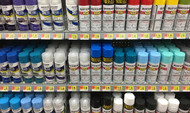How to Paint Plastic Interior Parts
Posted by Joshlin Grayson on Jul 7th 2020
Painting plastic interior car parts is very different from painting the outside of the car, due to the fact that interior parts are often made out of plastic. Depending on the make, model, and year of your car, you may find that even your wood-like and chrome accents are also made of plastic. Fortunately, many of these parts can be painted over to provide a custom look, however, plastic car parts do not take to paint in the same way as their metal counterparts.
All plastics are not created equal, and the different plastics all require a different prep. On the back of nearly every plastic part is a marking that identifies the type of plastic being used. Here is a cheat sheet that gives you an idea of the different types of plastic and how to prep each part. You can usually identify the type of part by recognizing its initials; here are some of the most common plastics used:
- PP - Polypropylene
- ABS - Acrylonitrile Butadiene Styrene
- PPS - Polyphenylene Sulfide
- PA - Nylon or Polyamides
- PV - Polyvinyl Chloride
|
ABS (textured): |
Abrase with 300 grit sandpaper, and wipe with acetone |
|
ABS (smooth): |
Abrase with 600 grit, and wipe with rubbing alcohol |
|
PVC (textured): |
Abrase with 300 grit, and wipe with acetone |
|
PVC (smooth): |
Abrase with 600 grit, and wipe with rubbing alcohol |
|
PVC soft (soft-touch parts like a dashboard or center armrest): |
Abrase with 400 grit (but do not tear the surface), and wipe with rubbing alcohol |
|
PA (smooth): |
Abrase with 600 grit, and wipe with rubbing alcohol |
|
PPS and PP: |
Soak in a water-based degreaser to remove oils, then abrase with 300 grit, and wipe with both acetone and rubbing alcohol |
Wash It
The first step to preparing your interior part for paint is to remove it from the car, and soak the part in soapy water. If you cannot remove the part, be sure to use a solid masking tape and lots of protection to prevent overspray.
Preferably, use dish soap because it breaks down grease far better than a hand soap or car wash soap. Many plastic parts have years of polish, grease, and oils built up from many layers of polish, Armor All, etc., that may keep the part looking good, but will prevent paint from penetrating unless it is properly removed.
Prime It
Once your part is clean, prime your part using a high-quality spray primer. Look for a primer that is labeled “Adhesion Promoter”, and be sure to use it on both the front and back of your part. Use two to three layers of primer, letting each coat dry for about 20 minutes before applying the next layer. This will allow even coverage, and prevent the old color from showing through the new paint.
Paint It
Spray your part with a high-quality paint using smooth strokes from 8-12” away. Use 3-4 coats of paint to ensure even coverage, letting the paint dry for about 20 minutes between coats.
Once you’ve finished painting your plastic parts, allow your paint to dry overnight before finishing it with a clear coat paint. Once your paint has dried, follow the same process using a high-quality clear coat paint.
You’re all set! Your plastic parts are now painted, and you’re well on your way to getting your car that much more perfect.
For all of your needed auto restoration supplies, visit no one other than Collectors Auto Supply, and get the best service in classic car auto parts.

